JVS October Open-Access Articles Announced
Four articles in the Journal of Vascular Surgery are available with free access for October. They are:
Four articles in the Journal of Vascular Surgery are available with free access for October. They are:
The Journal of Vascular Surgery (JVS) and JVS-Venous and Lymphatic Disorders (JVS-VL) offer open-access articles to non-subscribers for 30 (JVS) and 60 (JVS-VL) days after publication. Here are the open-access articles for November.
JVS:
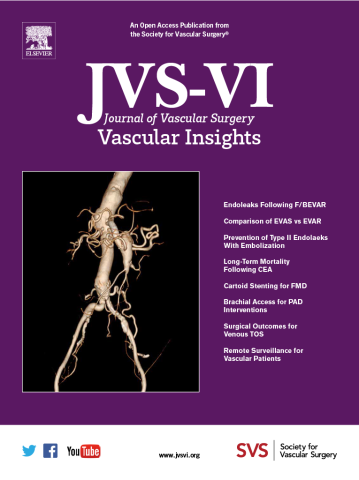
JVS-Vascular Insights (JVS-VI) is the latest companion journal to the Journal of Vascular Surgery, the premier international journal of medical, endovascular, and surgical care of patients with vascular disease. JVS-Vascular Insights is committed to publishing high-quality research in vascular surgery, including practice management, business and ethical aspects of vascular surgical practice, education, and DEI (diversity, equity, inclusion), as well as traditional clinical studies for its readership of community practice and academic vascular surgeons. JVS-Vascular Insights aims to provide a venue for both long-form research (e.g., clinical papers, review articles and meta-analyses) and early-stage or hypothesis-generating work (e.g., emerging data, trial protocols, pilot studies, community surgical reports). Case reports, small case series, innovation, and technique articles should be submitted to JVS-Cases, Innovations & Techniques. Authors considering submitting their work for publication are encouraged to include digital media such as graphical abstracts and any relevant supplemental content to facilitate open data sharing and transparency-in line with the journal's open science approach.
JVS-Vascular Insights is a fully open access member of the JVS journals portfolio, which also includes the flagship Journal of Vascular Surgery and the specialty journals JVS-Venous and Lymphatic Disorders, JVS-Cases, Innovations & Techniques, and JVS-Vascular Science. All JVS Journals operate within the same transfer article network, which allows the Editors, at their discretion, to recommend manuscript transfer to any of the other four JVS Journals.
“Which of the operations we are doing today will be the discards of the next decade? What is needed is knowledge and such knowledge will be provided by the young amongst us and those yet to come.” – Allan Callow, 1987
The idea for the creation of a charitable foundation for the promotion of research came about at the 1984 the Society for Vascular Surgery (SVS) Council meeting. Dr. Allan Callow requested the “Council’s consideration for the utilization of certain assets of the Society to further the interests of young surgeons in the specialty of vascular surgery.”
In the early 1980s, vascular surgeons had become experts in the surgical treatment of atherosclerosis obliterans. However, fundamental knowledge about the atherosclerosis obliterans and fundamental insights into the pathogenesis of neointimal hyperplasia were lacking. Vascular surgical research generally consisted of implanting prosthetic devices in the arterial system and studying patency. Vascular surgeons were only beginning to investigate the basic biologic mechanisms utilizing cell and molecular technology.
Unfortunately, funding for research at the time was difficult and discouraged many young investigators. National Institutes of Health (NIH) funding of grants was low, particularly for surgeons. In 1982 departments of surgery received only 5.1 percent of the total research allotment of the NIH and funding was declining. It also became apparent to SVS leaders that, with the rapid expansion of biologic investigations, dabbling in basic science research was no longer possible. Basic science required substantial commitment by young investigative clinician/scientists to compete with non‐surgical colleagues. The SVS recognized the time commitment needed for career development and the financial resources required in the establishment of the foundation.
The SVS Board approved the Education/Research Foundation at the Council meeting. The new foundation’s board of directors met in New Orleans on October 22, 1986. The first board members included Vic Bernhardt, Allan Callow, Cal Ernst, Wesley Moore and Malcolm Perry. At this first meeting, officers were elected: Cal Ernst, president; Vic Bernhardt, vice president; and Malcolm Perry, secretary/treasurer. The foundation’s financial support was a grant of $50,000 from SVS; W. L. Gore, $10,000; and contributions from board of directors’ members, $4,000.
Dr. Gene Strandness established the first Research Initiatives Conference in conjunction with the NIH and the National Heart, Lung, and Blood Institute (NHLBI). Dr. Strandness had served on the NHLBI Cardiology Advisory Committee and developed a relationship with Dr. John Watson, the chief of the Devices and Technology Branch. Together they envisioned a workshop to bring together vascular surgeons and members of the NIH to attract the best scientific minds available in the research community to serve as an incubator for ideas. The first meeting resulted in a book entitled Vascular Diseases: Current Research and Clinical Applications published in1987. The first meeting of the Research Initiatives programs was held February 19‐20, 1988 in Bethesda, MD. This was jointly sponsored by SVS and the North American Chapter, International Society for Cardiovascular Surgery (NA-ISCVS).
Dr. Michael DeBakey became foundation president and the foundation was registered in Illinois as a legal entity.
The Foundation for Research and Education adopted a new name: The Lifeline Foundation. The SVS leadership and the Lifeline Foundation leadership asked the SVS council for $100,000 annually for five years to establish funding for the first award. The foundation leaders included Drs. Michael DeBakey, Thomas Fogarty, Robert Leather, John Mannick, John Ochsner, Ronald Stoney, Vic Bernhardt, Malcom Perry, Allan Callow, Wesley Moore, and E. Stanley Crawford.
Dr. Cal Ernst served as an executive director of the foundation for five years, creating programs such as the Industrial Advisory Committee (IAC) and the first award of $50,000 for two years. The first grant awarded was presented to Brian Rubin, Washington University, to study the effects of the duration of thrombosis on vessel wall thrombogenicity. The IAC, which was created at the suggestion of Dr. Ron Stoney, allowed industry participation in the foundation and provided a closer liaison between the two groups.
Dr. Ron Stoney was the foundation’s executive director with support from Joe Stone, executive director of PRRI Management Firm. In 1994 the Lifeline Foundation’s mission was formalized to support research and education in vascular disease by 1) enhancing the development of young surgical scientists in the advancement of vascular science through its comprehensive research funding commitment; and 2) insuring that new knowledge concerning the cause, treatment, and prevention of vascular disease is disseminated to the medical profession and the public. To this end, the board of directors with the Joint Council established a research forum at the annual joint meeting in 1994 with more than 150 abstracts being submitted. The board was expanded to include members from industry and the lay public.
The NA-ISCVS Council agreed to match support from the SVS of $100,000 for five years for equal representation in the Lifeline Foundation. The inclusion of ISCVS increased the board of directors’ membership to include representation from the ISCVS and was associated with the transfer of the Student Fellowship Research Award to the Foundation.
By 1993 the foundation was ready to fund the second award, which was given to Dr. Colleen Brophy to study the molecular model of vasospasm. During the summer of 1993 the Lifeline Foundation officers requested support from the regional societies. The regional societies were supportive and provided funds ranging from $10,000 to $50,000.
Dr. John Mannick was the Lifeline Foundation president. During the first year of his leadership, the foundation was restructured to make it more responsive to the needs of its constituencies. Four new members from industry were added; all had voting privileges on the foundation. In addition, Dr. James Yao was asked to serve as the vice president for development, and liaisons from the NHLBI, David Robinson, and for clinical investigations, Dr. Rod White, were added.
The Endoluminal Graft Registry project was begun and was led by Dr. White. The Endoluminal Graft Registry recruited funding for a robust project to evaluate FDA‐approved endovascular devices. The Endovascular Registry reports were publicized in Journal for Vascular Surgery (J Vasc Surg 2005;42:1‐10).
Dr. Alex Clowes, along with Dr. Mannick, approached the NIH for co‐sponsorship of the KO8 grant. This was a landmark event for the foundation and vascular surgery. For the first time the NIH partnered with a society for sponsorship of a KO8 grant. The KO8 mechanism funded early career development of vascular surgeons/scientists. During this same interval Dr. Mannick proposed to the William von Liebig Foundation funding of these KO8 grants. Working with Linda Hamilton of the von Liebig Foundation, a memorandum of understanding was completed and signed in November 1998. At the same time, an anonymous donor provided $1 million in support for endowing clinical research grants. Dr. James Yao began an aggressive program of the membership, the regional societies, and industries for matching awards. The details of the endowment were that a corpus of $3 million was required before interest could be spent on funding awards.
Dr. Julius Jacobson and his family provided an endowment that supports the Research Initiatives program.
The first year of availability for the KO8‐von Liebig awards was July 1, 1999. During that year six applications were made for the grant and the first awardees were Dr. Michael Conte of Brigham and Women’s Hospital, Harvard Medical School, for a project entitled “Genetic Engineering of Failure‐Resistant Vein Graft” and Dr. Larry Kraiss of the University of Utah School of Medicine for his project entitled “Control of Endothelial Translation by Fluid Sheer Stresses.” As a result of the success with the NHLBI/Lifeline Foundation/von Liebig Foundation awards, discussions occurred at the Medical Research Council of Canada to allow the development of a similar program.
Dr. Julius Jacobson provided $500,000 for Research Initiatives Program support.
Requests for clinical research applications were accepted for the first funding by the K23 grant.
The SVS and AAVS (NA-ISCVS) merged to form the SVS and the process began to also merge both organizations’ foundations. The SVS’ Lifeline Foundation merged with the AAVS’ American Vascular Association (AVA) and continued operations under the AVA banner. The new foundation continued to support the research mission work of the Lifeline Foundation and the vascular disease awareness programs of the previous American Vascular Association which included a National Screening Program.
The SVS leadership and AVA board agreed that the name of the foundation should be changed to the SVS Foundation to clearly brand the foundation as the charitable arm of the SVS. A restructuring of the foundation occurred, with a majority of the SVS officers also serving as foundation leadership. The scope of the foundation’s mission was narrowed to focus on providing research support.
The SVS Foundation leadership recommended that the scope of the mission be expanded to include vascular disease awareness and prevention in addition to its core mission of research. (Source of 1984‐2002 information: SVS Foundation 20th anniversary promotion).
For more on the original AVA and Lifeline Foundation, follow this link to a Journal of Vascular Surgery article published in 2008.
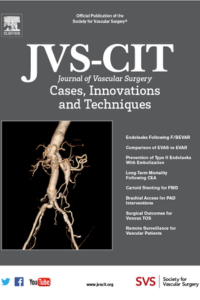
JVS-CIT aims to be the premier international journal of medical, endovascular, and surgical care of vascular diseases by publishing high quality case reports, articles on innovations and on endovascular and surgical techniques.
Published 6 times annually
Online-only
Fully open-access
2022 Impact Factor 0.7
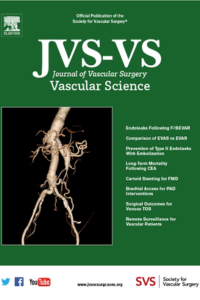
JVS-VS aims to be the premier international journal publishing “bench-to-bedside” experimental and translational research underlying modern medical, endovascular and surgical investigation and management of vascular diseases. JVS-Vascular Science is dedicated to the science and art of vascular medicine, radiology, surgery and endovascular interventions
Published in one rolling annual issue
Online-only
Fully open-access
The Journal of Vascular Surgery: Venous and Lymphatic Disorders aims to be the premier international journal of medical, endovascular and surgical care of venous and lymphatic disorders. It publishes high-quality clinical research, techniques, and practice manuscripts related to all aspects of venous and lymphatic disorders, including malformations and wound care, with an emphasis on the practicing clinician.
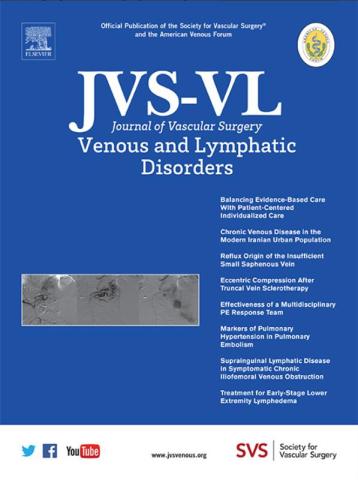
Published 6 times annually
Online only
Open-access
2022 Impact Factor: 3.2
We are pleased to inform you that the Journal of Vascular Surgery: Venous and Lymphatic Disorders (JVS:VL) will be open access as of January 2024. Stay up-to-date on all the latest research by signing up for regular content alerts today (see link below).
Continue to enjoy all your current JVS:VL benefits in addition to these exclusive online features:
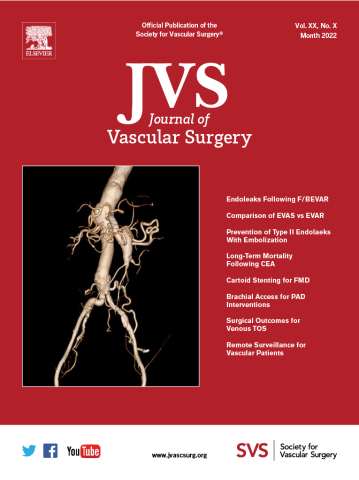
The Journal of Vascular Surgery® (JVS) is the official journal of the Society for Vascular Surgery® (SVS). Since the first issue was released in 1984, JVS has offered vascular, cardiothoracic, and general surgeons with original, peer-reviewed articles related to:
In recent years, the Journal has also published a number of supplemental issues focused on patient diversity, diabetic foot ulcers and other issues pertinent to practicing vascular surgeons.
Each month, JVS is mailed to nearly 4,000 subscribers. The Journal’s 2022 impact factor, a calculation of average citations per article, is 4.3.
JVS subscriptions are a benefit included in Active membership with the Society for Vascular Surgery but are also available to non-members.
The Journal of vascular surgery
The SVS/JVS Editorial Office does not manage advertising.
A COMPARISON BETWEEN INTRAVASCULAR ULTRASOUND AND VENOGRAPHY IN IDENTITYING KEY PARAMETERS ESSENTIAL FOR ILIAC VEIN STENTING.
November 2019 Journal of Vascular Surgery: Venous and Lymphatic Disorders